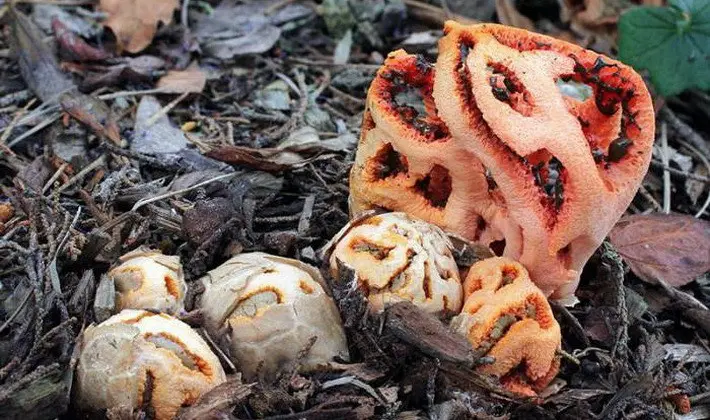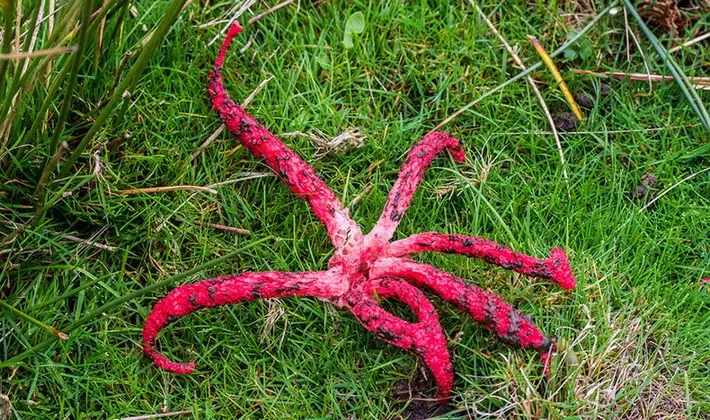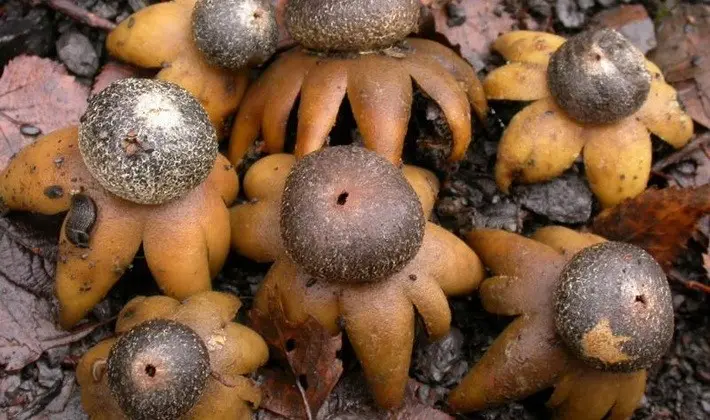Contents
- Unusual mushrooms from the Discinaceae and Lobe families
- Mushrooms of an unusual shape from the Morel family
- Unusual mushrooms from the Lociaceae family
- Mushrooms of an unusual shape from the Otideaceae and Petsitsevye families
- Unusual mushrooms from the Pyronemaceae and Sarcosciphoid families
- Mushrooms of an unusual shape from the Chanterelle and Veselkovye families
- Unusual mushrooms from the Star and False rainfly families
Mother nature is generous with surprises. Some mushrooms have such an unusual shape that one can only marvel at looking at their bizarre outlines. There are fruit bodies that look like a disk or a funnel, others resemble a brain or a saddle, and sometimes there are those that resemble stars. You can find photos and descriptions of the most unusual mushrooms in this material.
Unusual mushrooms from the Discinaceae and Lobe families
Common line (Gyromitra esculenta).
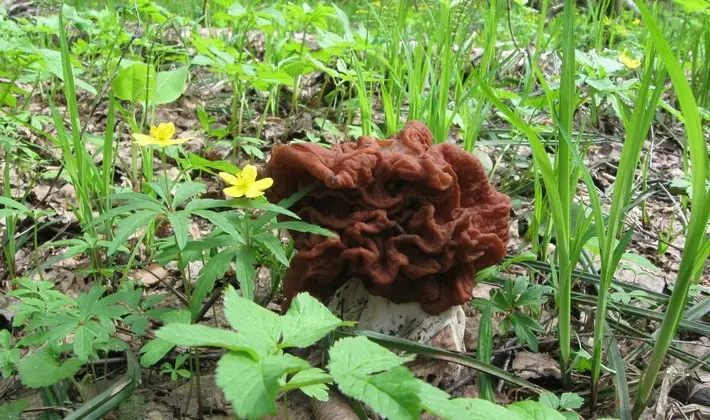
Family: Discinaceae (Discinaceae)
Season: end of April – end of May
Growth: alone and in groups
Description:
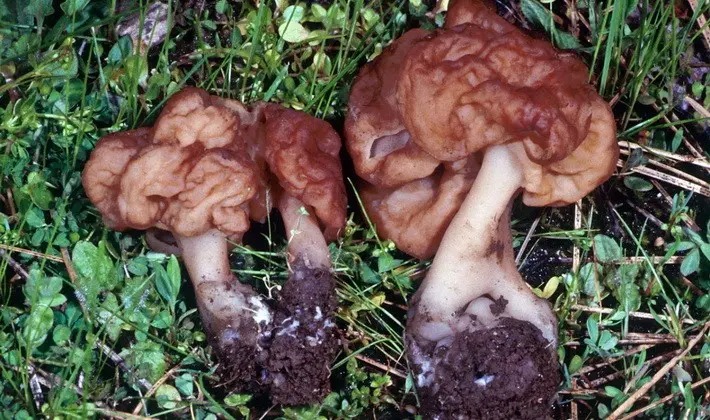
The leg is slightly folded, often narrowed towards the base, hollow, light.
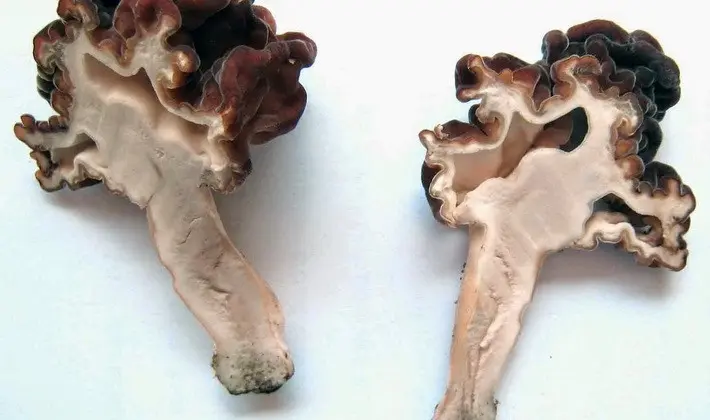
The pulp is waxy, fragile, light, without a special smell.

The edge of the cap is adherent to the stem along almost the entire length. The cap is wrinkled-folded, brain-shaped, brown, brightens with age. Inside the cap is sinuously hollow
This unusually shaped mushroom is poisonous. Contains gyromitrins that destroy the blood, as well as the central nervous system, liver and gastrointestinal tract.
Ecology and distribution: It grows in mixed and coniferous forests, in young pine plantations, in clearings, along roads.
Curly lobe (Helvella crispa).
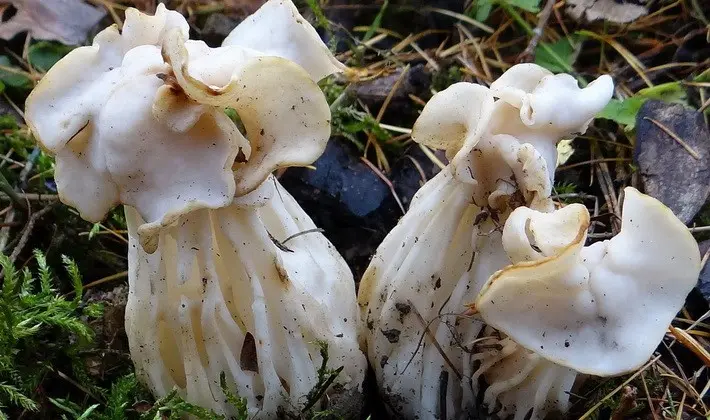
Family: Lopatnikovye (Helvellaceae).
Season: end of August – October.
Growth: singly and in groups.
Description:
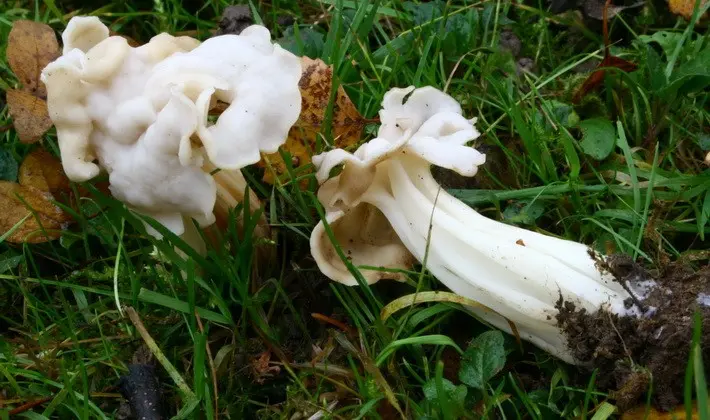
The pulp is brittle, whitish, odorless.
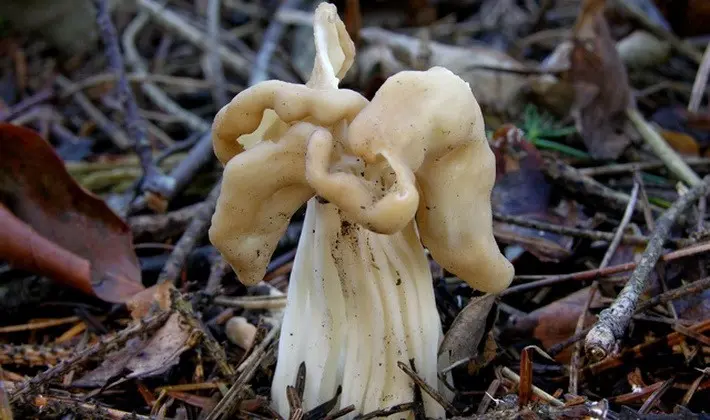
Hat, curved, two- or four-lobed, light yellow or ocher. The edge of the cap is free, wavy-curly, in some places grown.
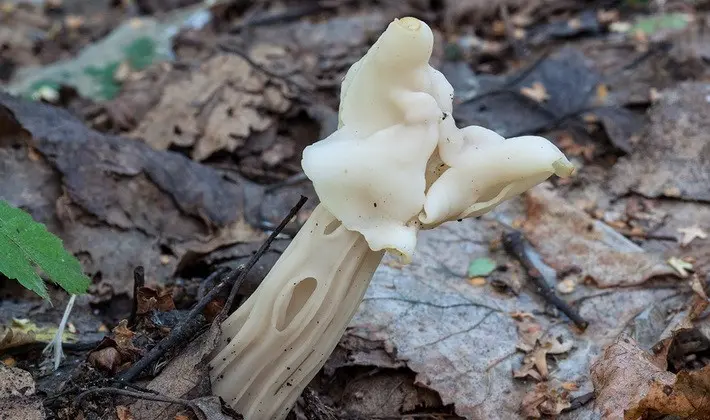
Leg foveate-striated, widened towards the base, hollow, light.
Conditionally edible mushroom of poor quality. It is used fresh (after preliminary boiling with draining the broth) and dried.
See what this unusual mushroom looks like in the photo:
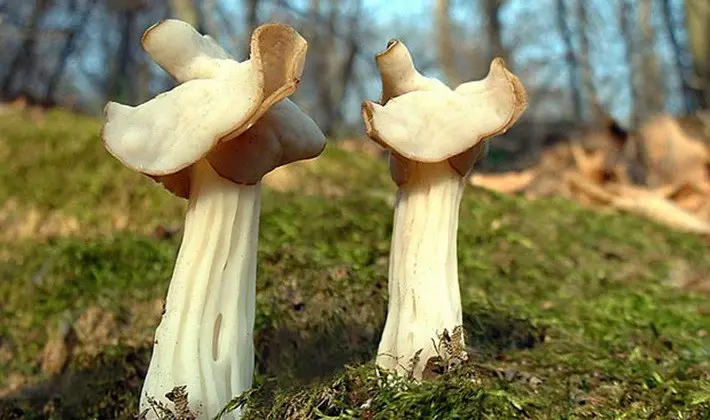
Ecology and distribution:
It grows in deciduous and mixed forests, in bushes, in grass, along roadsides. Occurs rarely.
Pitted lobe (Helvetia lacunosa).
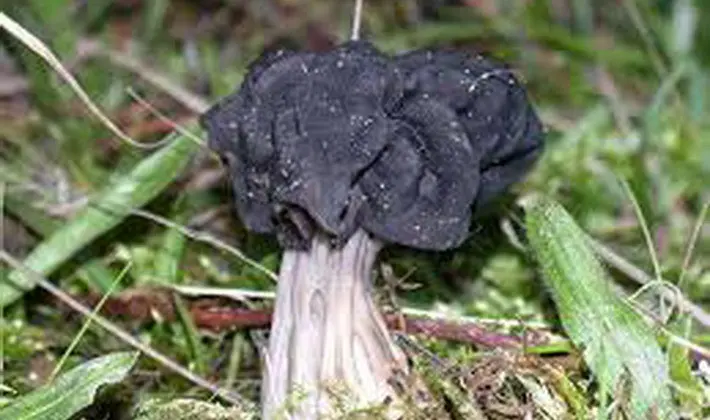
Family: Lopatnikovye (Helvellaceae).
Season: July – September.
Growth: singly and in groups.
Description:
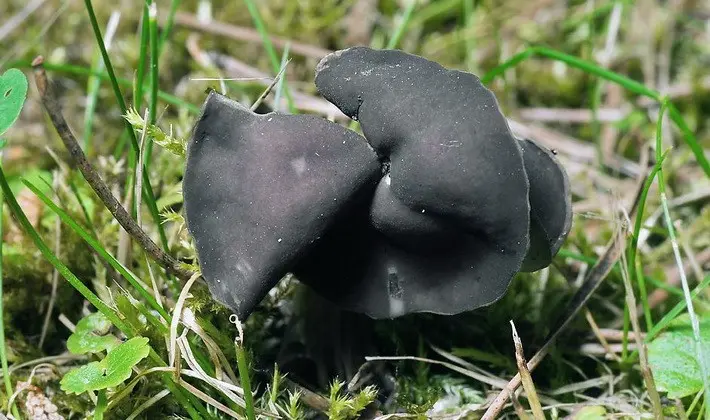
The cap is formed by two or three irregularly saddle-shaped lobes, the color is from grayish-bluish to dark gray.
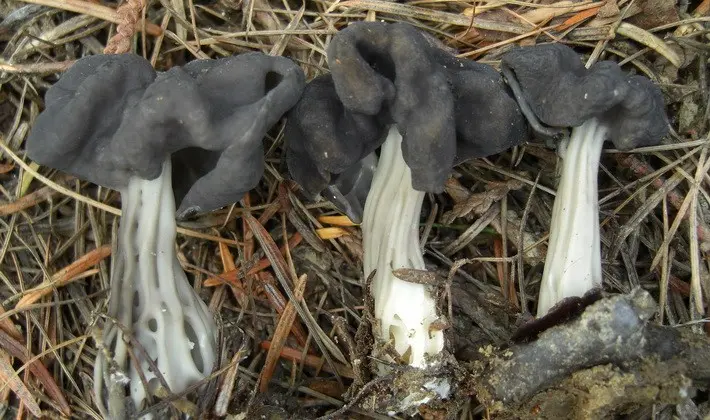
Leg – irregularly cylindrical or in the form of a narrow club, pitted, with sharp ribs, gray tones.
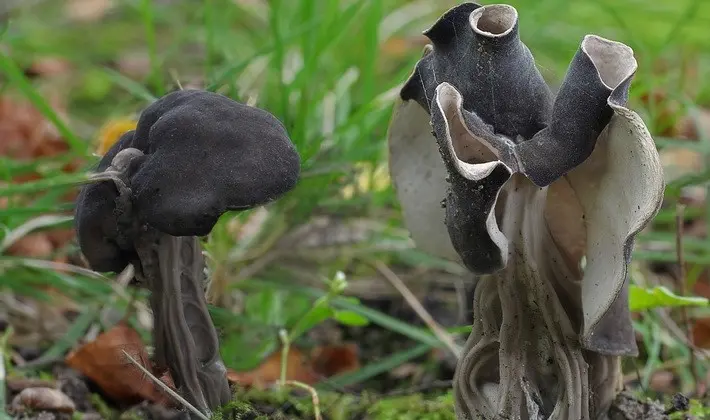
The pulp is very brittle, the taste and smell of young mushrooms are spicy, with age they become musty, earthy.
An unusual mushroom called pitted lobe is conditionally edible. Young specimens are tasty, although somewhat tough.
Ecology and distribution:
It grows in deciduous and mixed, less often in coniferous forests, on bare ground and among vegetation. Prefers acidic soils.
Mushrooms of an unusual shape from the Morel family
High morel (Morchella elata).
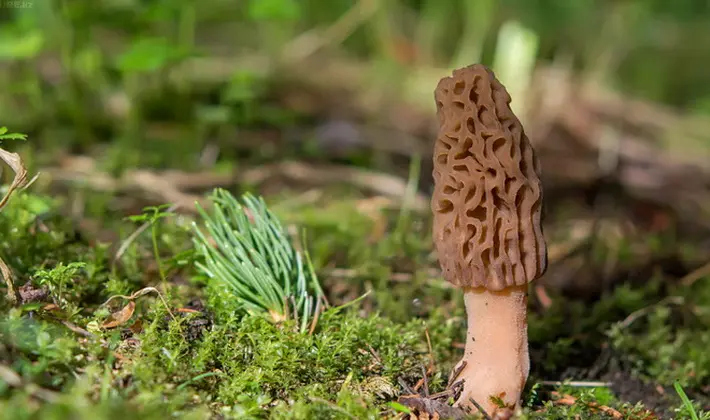
Family: Morels (Morchellaceae).
Season: April June.
Growth: alone and in small groups.
Description:
The pulp is white, tender, hollow inside, with an earthy or mushroom smell. The cells are olive-brown, in mature mushrooms they are brown or black-brown.
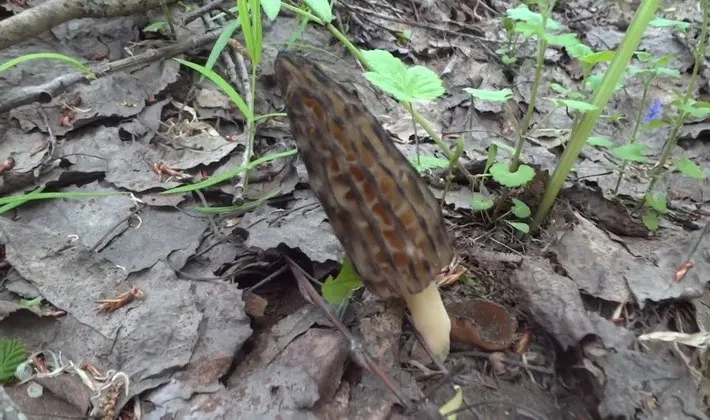
The cap is narrow, conical, covered with cells bounded by more or less parallel vertical narrow folds.
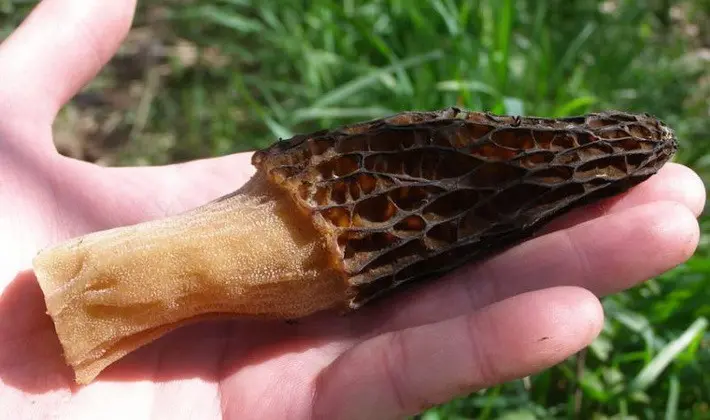
The leg is folded, expanded at the base, hollow, whitish in young mushrooms, later – yellowish or ocher. Partitions are olive-ocher; The color of the fungus darkens with age.
Conditionally edible mushroom. It is suitable for food after boiling for 10-15 minutes (the broth is drained), or after drying for 30-40 days.
Ecology and distribution:
Grows on soil in coniferous and deciduous forests, often – on grassy glades and edges, in gardens and orchards.
Real morel (Morchella esculenta).
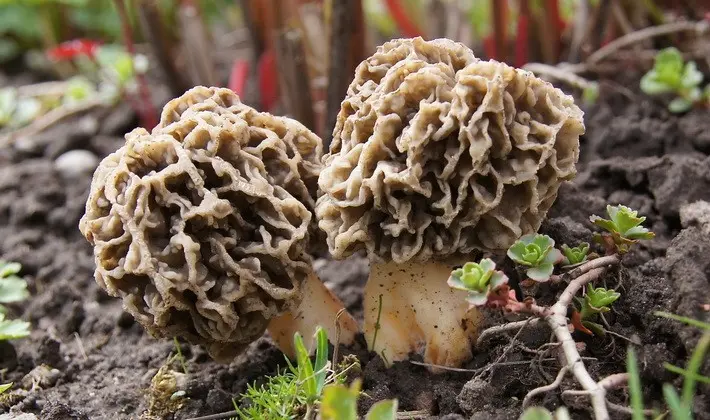
Family: Morels (Morchellaceae).
Season: early May – mid June.
Growth: singly and in groups.
Description:
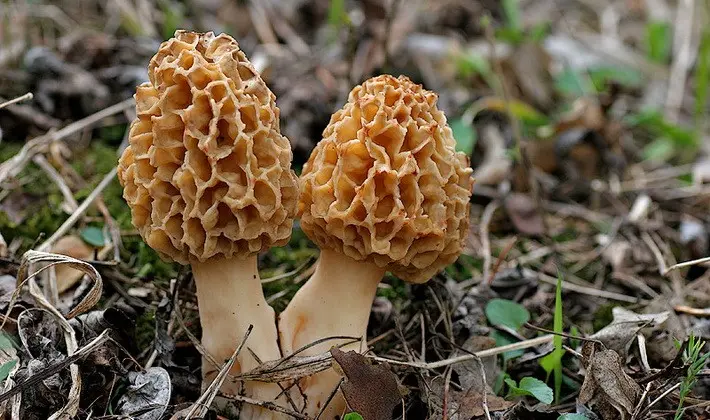
The stem fuses with the edge of the cap.
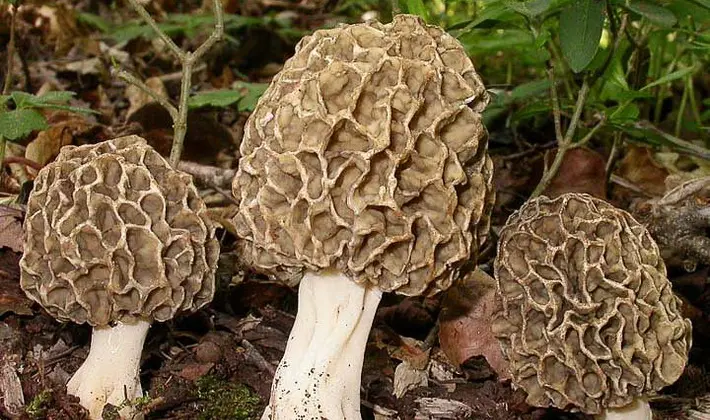
The mushroom is hollow inside. The hat is round-spherical, brown, coarse-meshed.
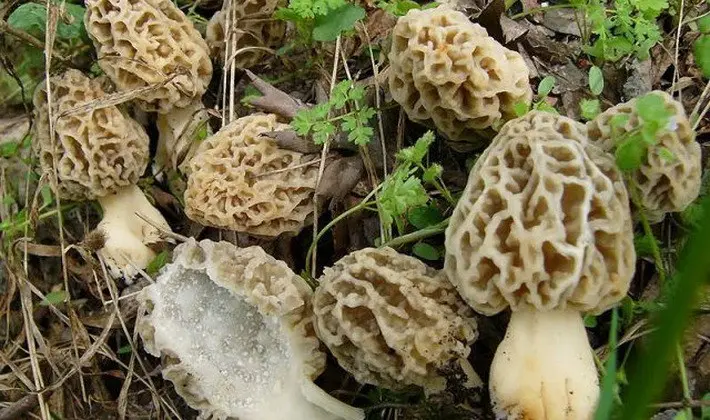
The flesh is waxy, brittle, with a pleasant groin and taste. The leg is whitish or yellowish in color, expanded below, often notched.
Delicious conditionally edible mushroom. It is suitable for food after boiling for 10-15 minutes (the broth is drained), or dried.
Ecology and distribution:
It grows in light deciduous, as well as in mixed and coniferous forests, in parks and gardens, on grassy lawns and forest edges, under bushes, in clearings.
Cap conical (Verpa conica).

Family: Morels (Morchellaceae).
Season: April May.
Growth: singly and in scattered groups.
Description:
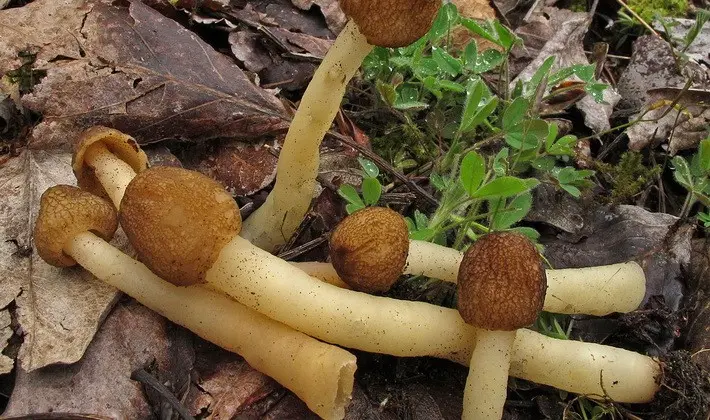
The leg is cylindrical or laterally flattened, hollow, brittle, covered with bran-like scales; the color is white, then turns yellow.
The hat is bell-shaped, brown tones.
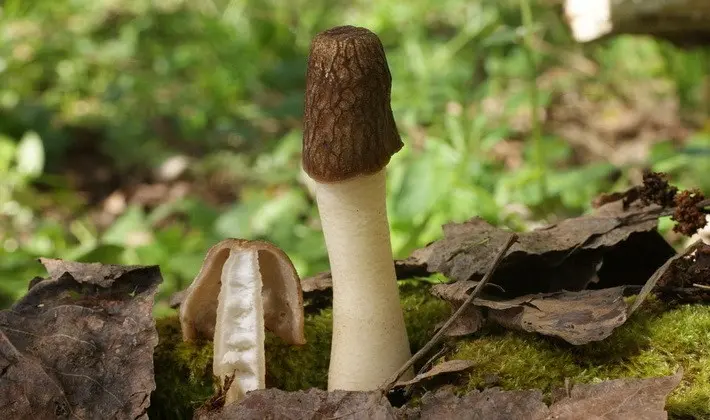
The pulp is tender, fragile. The surface of the cap is covered with shallow wrinkles, sometimes almost smooth, crumpled, usually present at the top.
This unusual mushroom is edible, it requires preliminary boiling (the broth is drained).
Ecology and distribution:
It grows in deciduous, mixed and floodplain forests, shrubs, forest belts, often near aspens, willows, birches. Occurs rarely.
Veined saucer (Disciotis venosa).
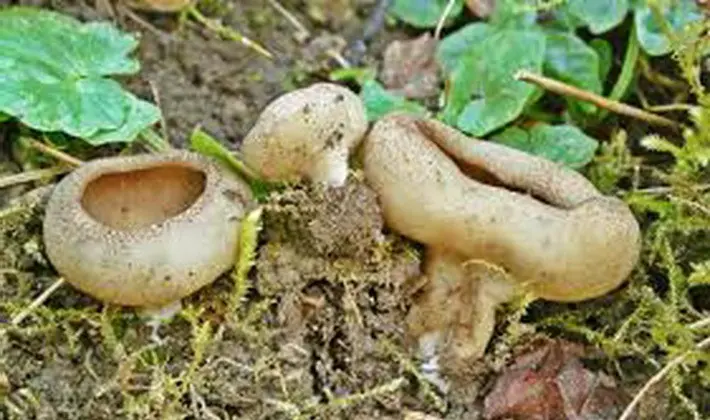
Family: Morels (Morchellaceae).
Season: April May.
Growth: singly or in small groups.
Description:
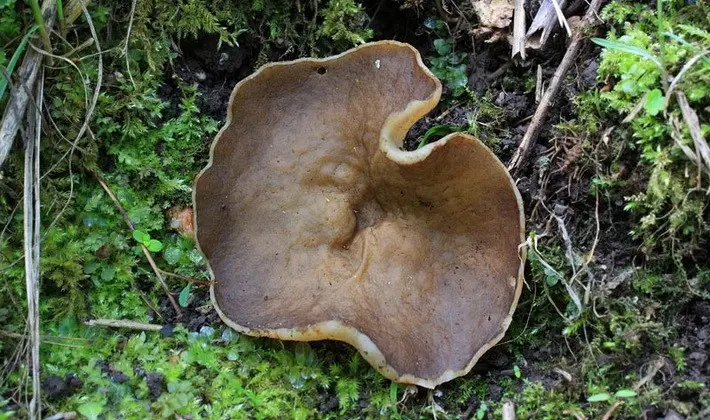
The outer surface is smooth, mealy or finely scaly, folded, whitish or ocher.
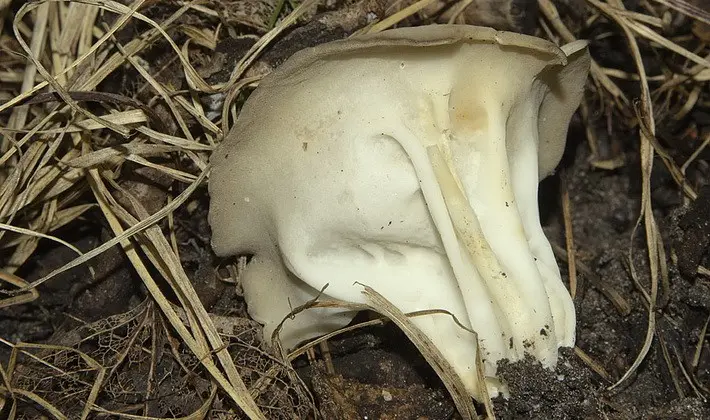
The flesh is brittle, with a mild taste and smell of chlorine. The inner surface is first smooth, ocher, then becomes radially ribbed, brown.
The fruit body is fleshy, first cup-shaped or saucer-shaped, then flat.
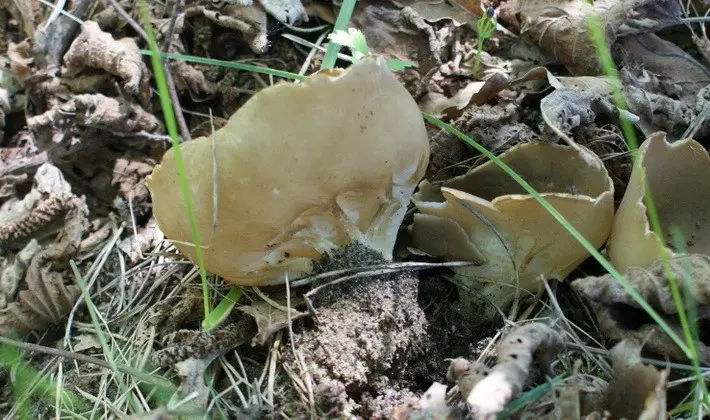
The short leg is immersed in the soil.
Poor quality edible mushroom. Requires pre-boiling to remove an unpleasant odor.
Ecology and distribution:
It grows on sandy soil in forests of various types, along roads, ravines, along stream banks, in clearings.
Unusual mushrooms from the Lociaceae family
Cup-shaped and disc-shaped, funnel-shaped mushrooms.
Bisporella lemon (Bisporella citrina).
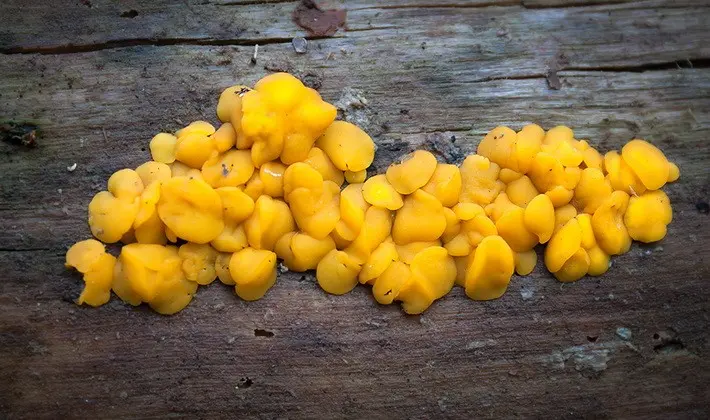
Family: Leocyaceae (Leotiaceae).
Season: mid-September – end of October.
Growth: large dense groups.
Description:
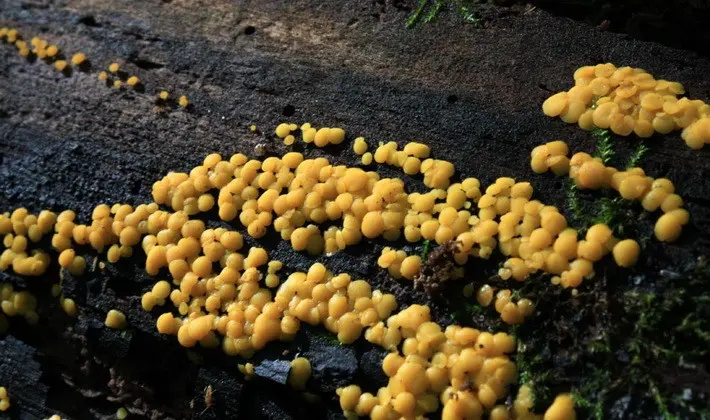
Fruit bodies are teardrop-shaped at first, convex. The surface is matte, lemon yellow or light yellow.
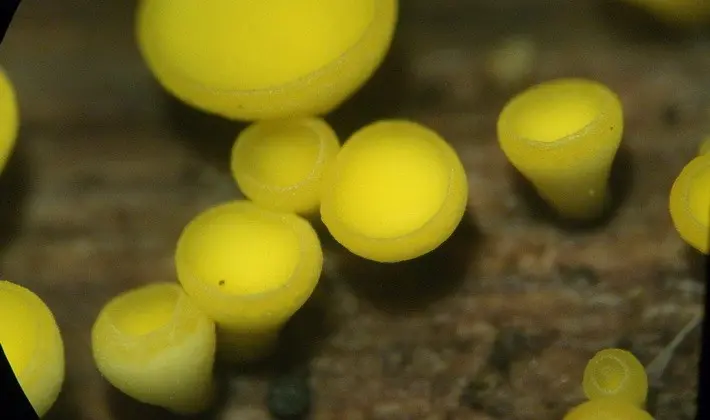
With age, the fruiting bodies become disc-shaped or goblet-shaped.
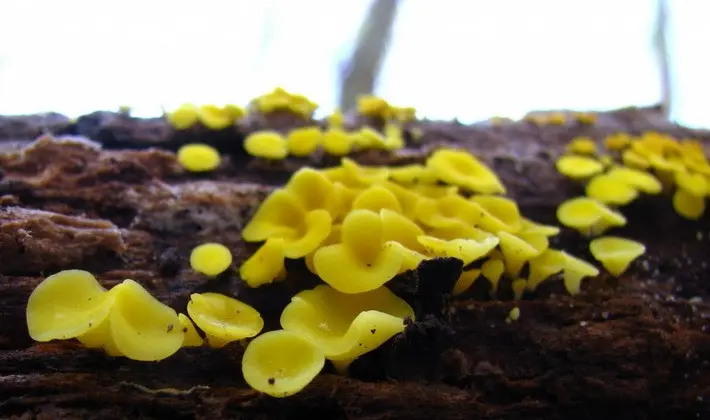
From top to bottom fruiting bodies are extended into a narrowed “leg”, sometimes degenerate.
Due to its small size, it has no nutritional value.
Ecology and distribution:
It grows in deciduous and mixed forests, on decaying hardwood (birch, linden, oak), on trunks, often at the end of a log – on the horizontal surface of log cabins and stumps, on branches.
Bulgar soiling (Bulgaria inquinans).
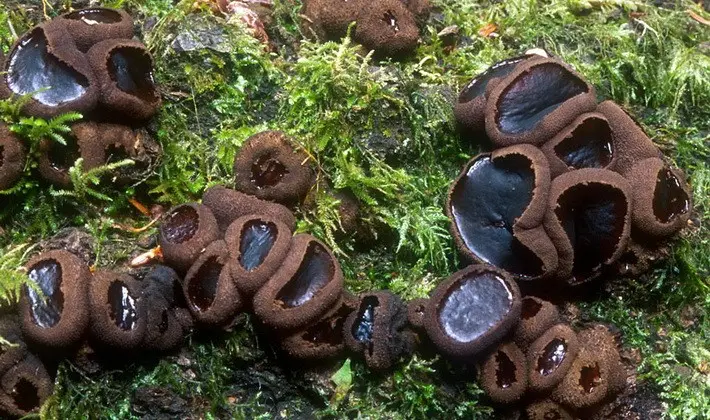
Family: Leocyaceae (Leotiaceae).
Season: mid-September – November.
Growth: in groups.
Description:
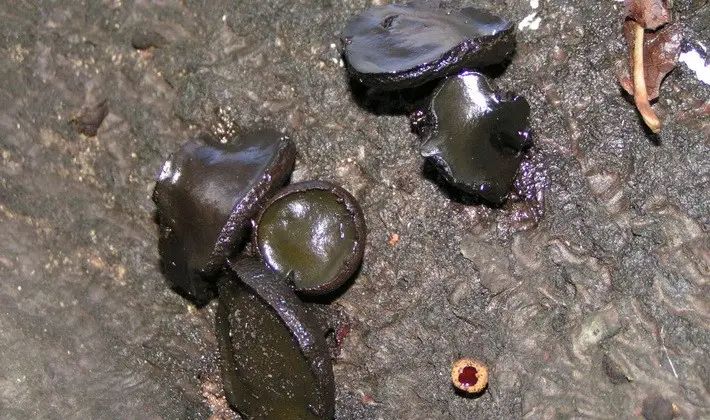
The pulp is gelatinous-elastic, dense, ocher-brown, becomes hard when dried.
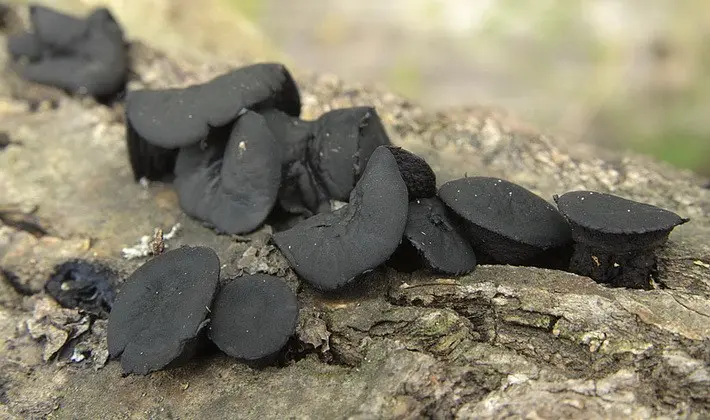
The black upper surface leaves marks on the fingers. The mature fruiting body is shaped like a wide glass.
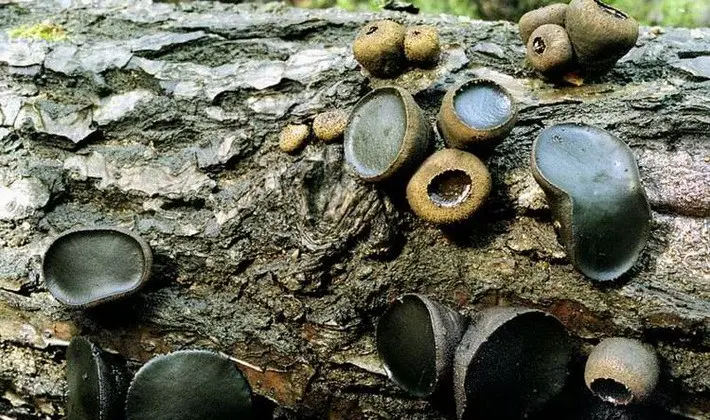
Young specimens goblet, brown.
Mushroom inedible.
Ecology and distribution:
Grows on dead wood and deadwood of hardwoods (oak, aspen).
Neobulgaria pure (Neobulgaria pura).
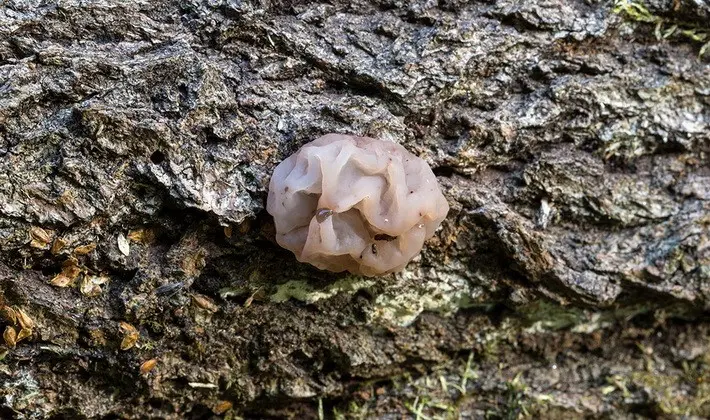
Family: Leocyaceae (Leotiaceae).
Season: mid-September – November.
Growth: tight clusters.
Description:
The inner surface is shiny, gray, grayish bluish or grayish brownish. The lateral surface is finely warty.

The pulp is fleshy, gelatinous, tender.
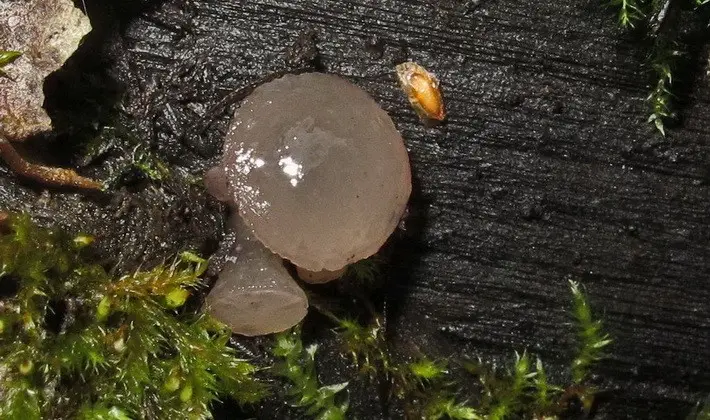
The fruiting body is cup-shaped, prominent, conically narrowed towards the base.
Mushroom inedible.
Ecology and distribution:
Grows on dead branches of deciduous trees (birch).
Mushrooms of an unusual shape from the Otideaceae and Petsitsevye families
Donkey otidea (Otidea onotica).
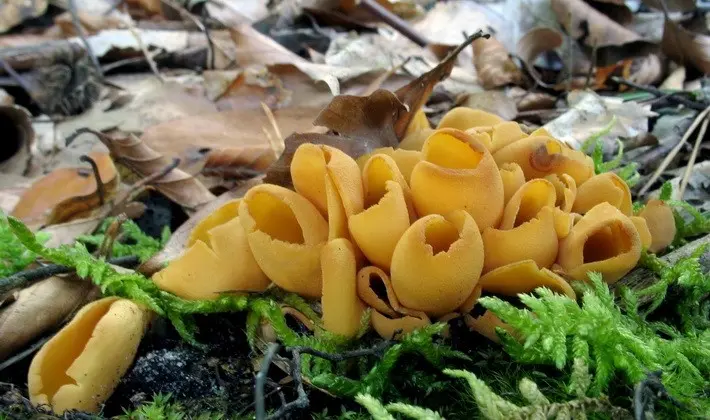
Family: Otideaceae (Otideaceae).
Season: beginning of July – mid-October.
Growth: in groups.
Description:
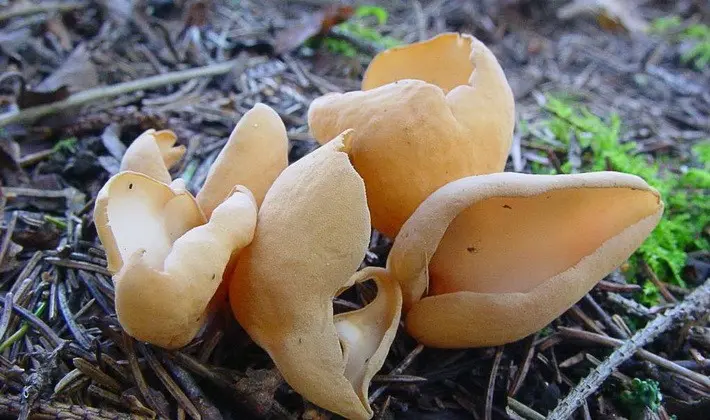
The fruiting body is ear-shaped, with curled edges. The inner surface is yellow-ochre, yellow-orange with a reddish tint and rusty spots.
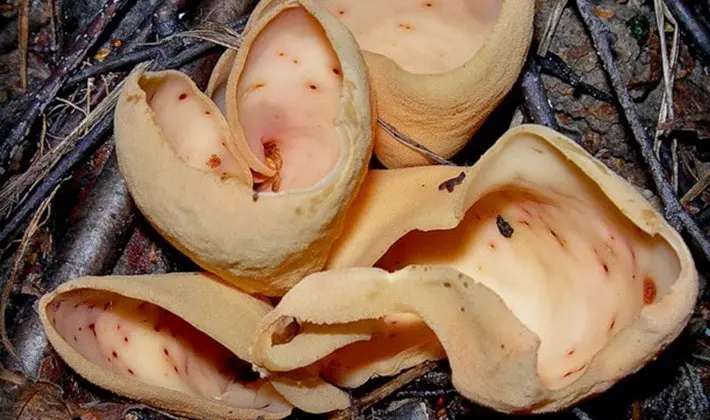
The flesh is thin, leathery, odorless.
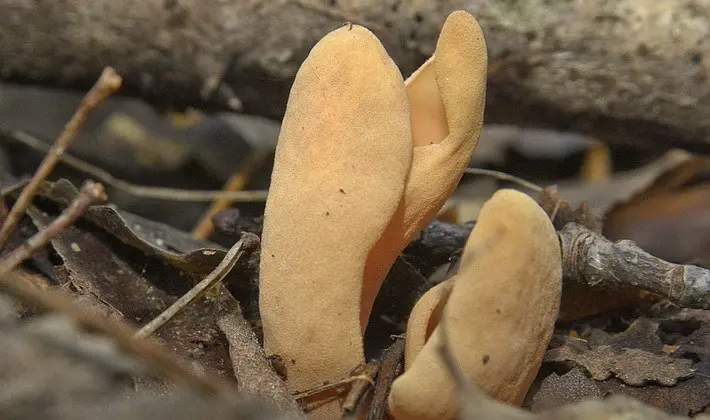
The outer surface is ocher, matte. There is a distinct short stem.
Poor quality edible mushroom. It is used fresh after preliminary boiling.
Ecology and distribution:
Grows on soil in deciduous and mixed forests. Distributed in the European part of Our Country and the Urals.
Brown pepper (Peziza badia).
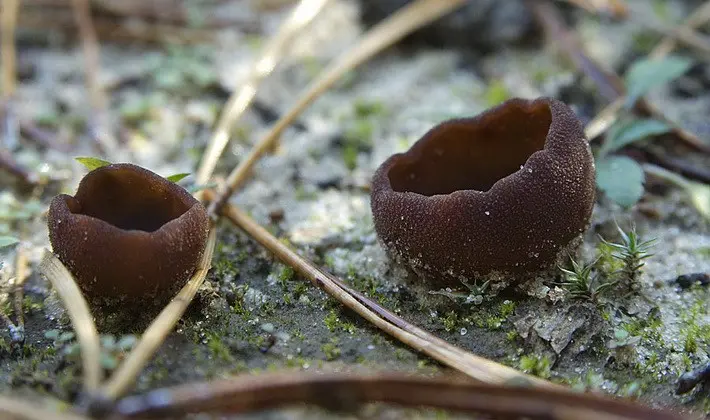
Family: Petsitsevye (Pezizaceae).
Season: mid-May – September.
Growth: in groups.
Description:
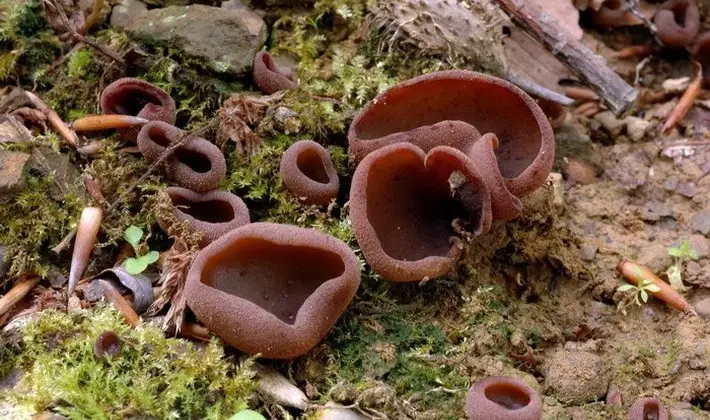
The outer surface is chestnut, granular. The inner surface is smooth, brilliant brown in wet weather.
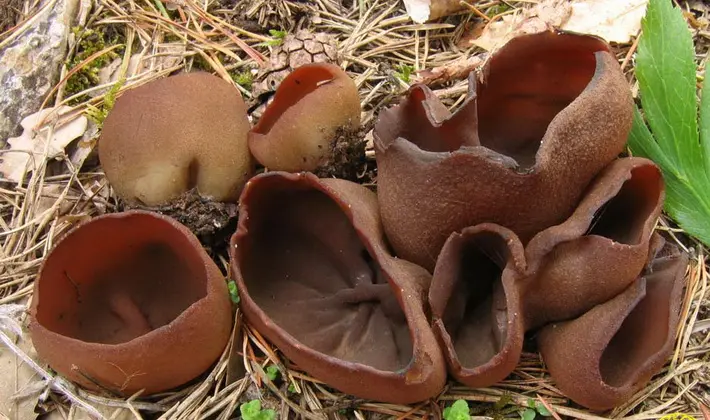
The fruiting body is sessile, hemispherical in youth, then gradually opens. The mature fruiting body is saucer-shaped with neatly tucked edges.
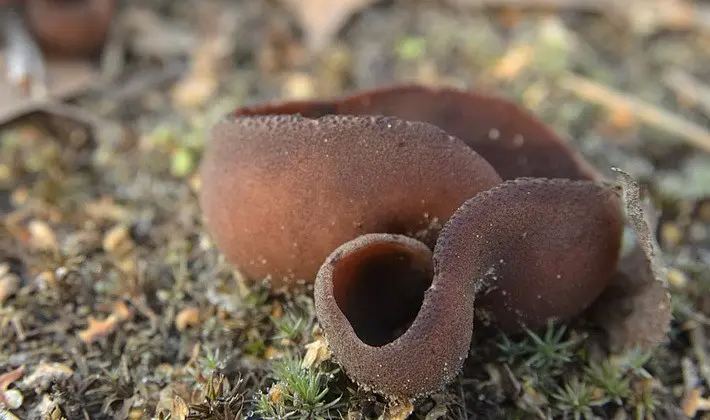
The pulp is brown, brittle, watery.
An edible mushroom of very low quality. It is used fresh after preliminary boiling, as well as dried.
Ecology and distribution:
It grows only in damp places on soil in coniferous and mixed forests, on dead hardwood (aspen, birch), on stumps, along roads.
Bubble pepper (Peziza vesiculosa).
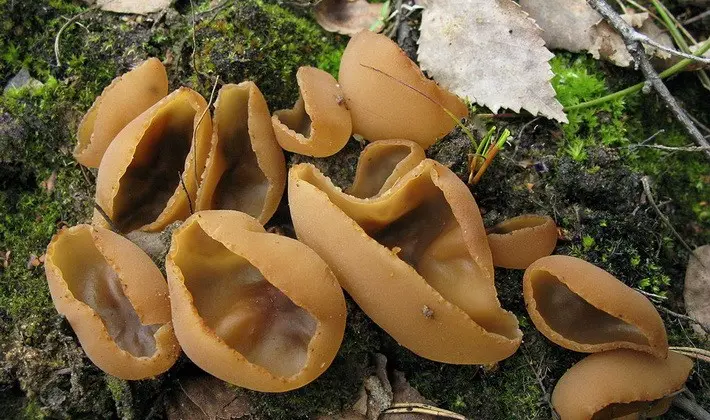
Family: Petsitsevye (Pezizaceae).
Season: end of May – October.
Growth: groups and alone.
Description:
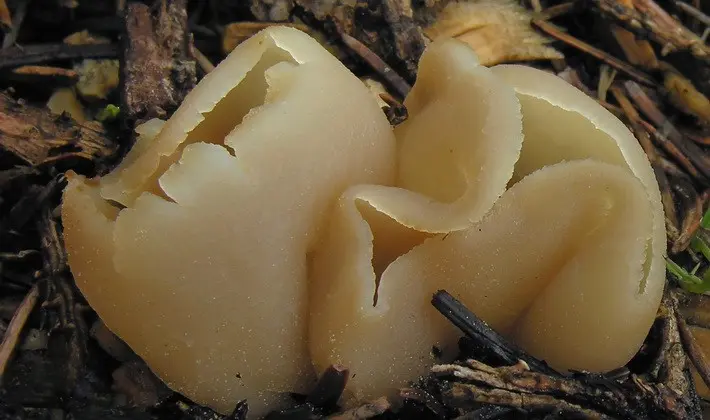
The fruiting body is at first almost spherical, then becomes cup-shaped with a torn, inward-turned edge. The inner surface is matte or slightly shiny, beige, light brownish in color with an olive tint.
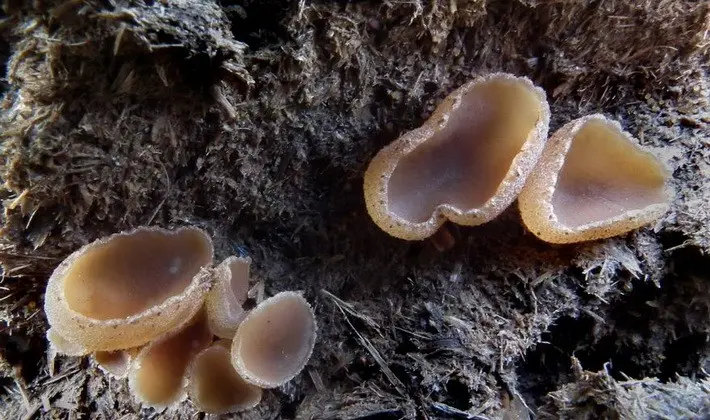
The outer surface is brownish-brown, powdery. Old fruiting bodies are saucer-shaped, often with a lobed dried edge, sessile or with a very short stalk.
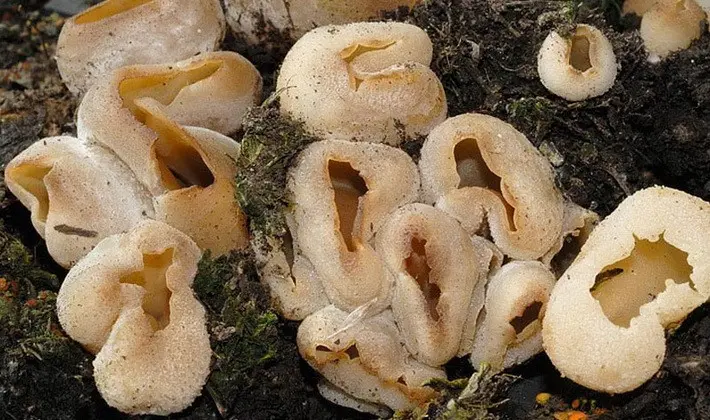
The pulp is brittle, waxy, brownish.
Information about edibility is contradictory. According to some reports, it can be used as food after boiling.
Ecology and distribution:
It grows in moist places on fertilized soil in forests and gardens, on rotten hardwood (birch, aspen), in landfills and flower beds.
Unusual mushrooms from the Pyronemaceae and Sarcosciphoid families
Aleuria orange (Aleuria aurantia).
Family: Pyronemaceae (Pyronemataceae).
Season: end of May – mid-September.
Growth: in groups.
Description:
The fruit body is sessile, cup-shaped, saucer-shaped or ear-shaped. The edges are curved unevenly. The outer surface is dull, matte, covered with white pubescence.
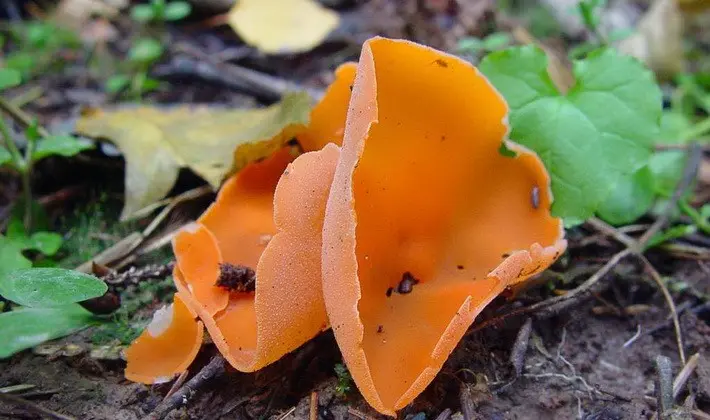
The flesh is whitish, thin, brittle, without a pronounced smell and taste.
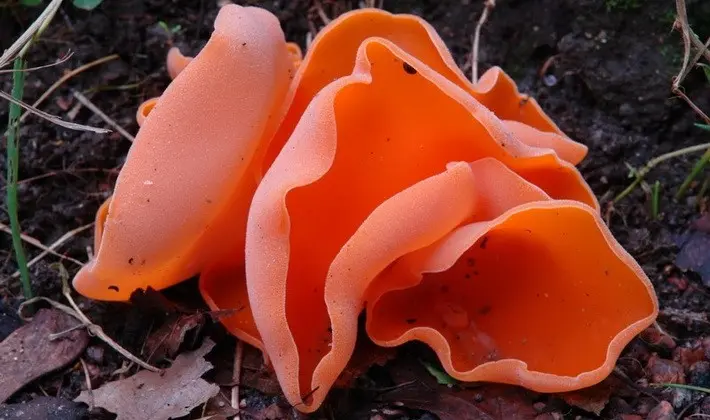
The inner surface is bright orange, smooth.
Poor quality edible mushroom. It is used fresh after preliminary boiling (for example, to decorate a salad) or dried.
Ecology and distribution:
It grows in deciduous and mixed forests on soil and rotting wood, in damp, but lit, bright places, in wet meadows, in gardens, along roads.
Scutellinia saucer (Scutellinia scutellata).
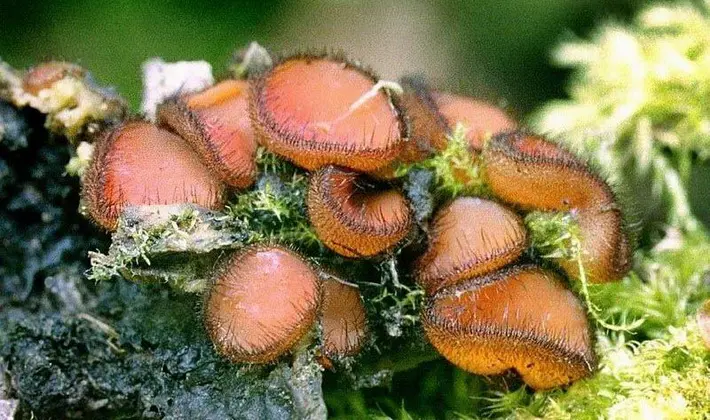
Family: Pyronemaceae (Pyronemataceae).
Season: end of May – November.
Growth: large dense groups.
Description:
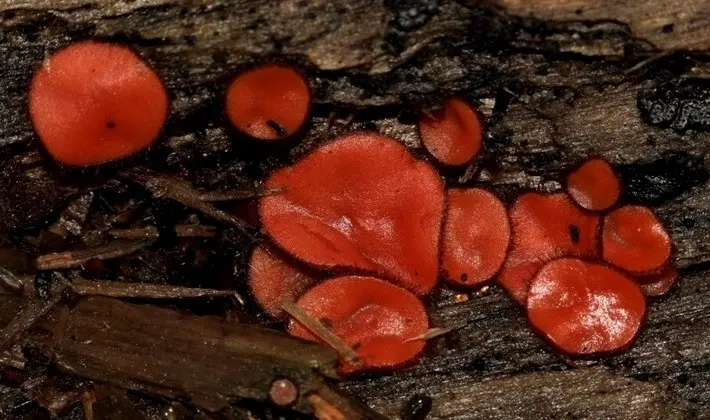
Mature fruit bodies are cup-shaped or disc-shaped, sessile. Young fruit bodies are spherical in shape, on a “leg”. The edge is framed by dark brown or almost black hairs.
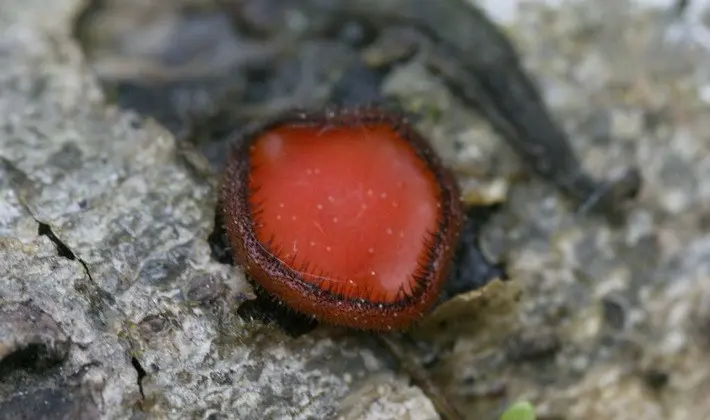
The flesh is thin, reddish, without much taste and smell.
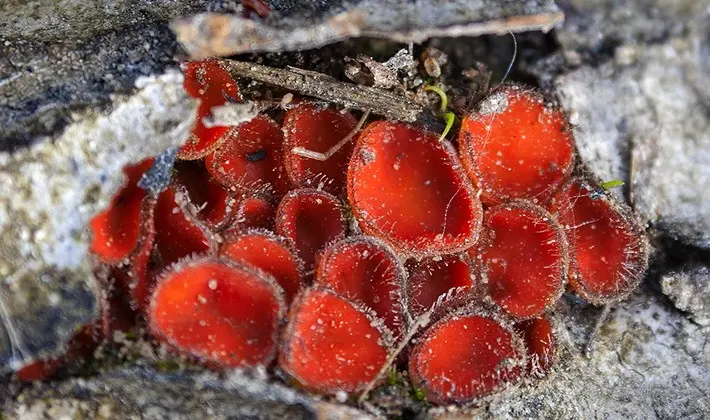
The inner surface is smooth, red-orange. The outer surface is light brown.
It has no nutritional value due to its small size.
Ecology and distribution:
Grows in damp places, on swampy lowlands on damp decaying wood (birch, aspen, rarely pine) and branches immersed in the soil.
Austrian Sarcoscypha (Sarcoscypha austriaca).
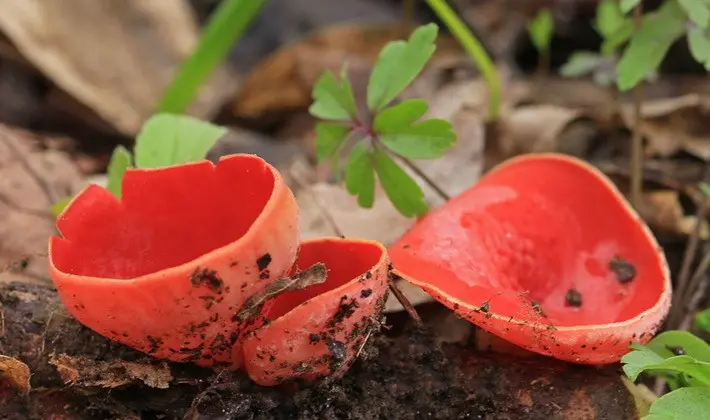
Family: Sarcosciphaceae (Sarcoscyphaceae).
Season: beginning of April – mid-May.
Growth: in groups.
Description:
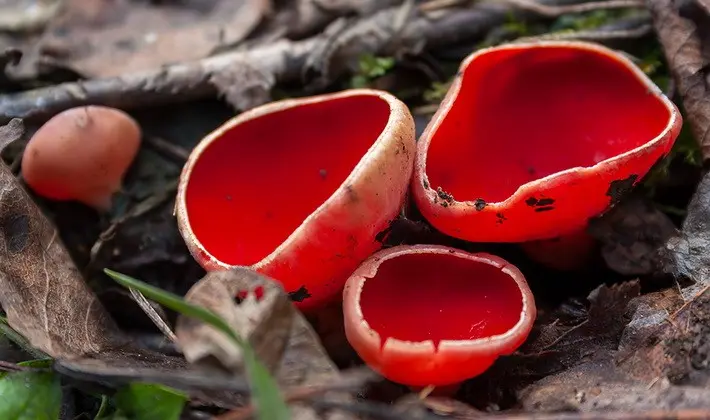
The inner surface is smooth, matte, bright red. The outer surface is vertically striated, whitish or pinkish.
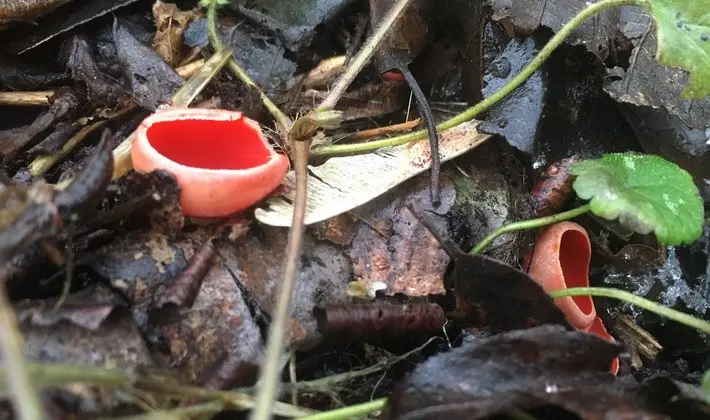
The pulp is dense, with a pleasant mushroom smell. The fruit body is goblet or cup-shaped.
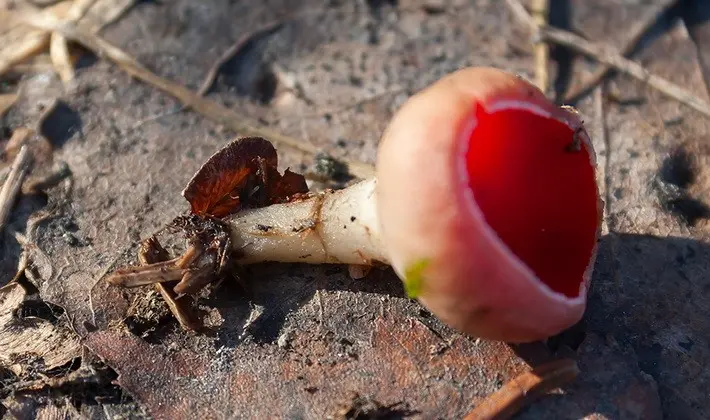
Leg tapering downwards. In old age, the fruiting bodies sometimes take on a disc-shaped shape.
Poor quality edible mushroom. Requires pre-cooking. Can be used to decorate dishes.
Ecology and distribution:
Grows in forests and parks on land rich in humus, on moss, rotting wood, rotten leaves or on root rot.
Mushrooms of an unusual shape from the Chanterelle and Veselkovye families
Horn-shaped funnel (Craterellus cornucopioides).
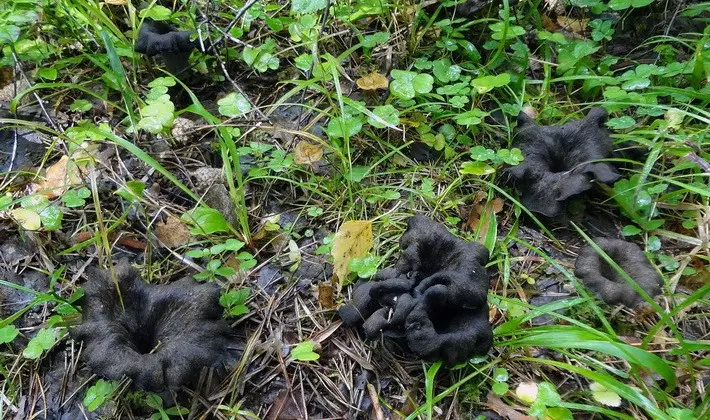
Family: Chanterelles (Cantharellaceae).
Season: beginning of July – end of September.
Growth: clusters and colonies.
Description:
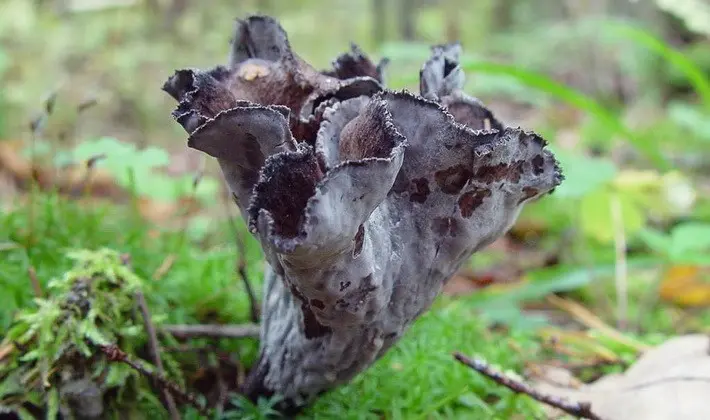
The outer surface is coarsely folded, waxy, gray. The cap is tubular, passes into a hollow leg.
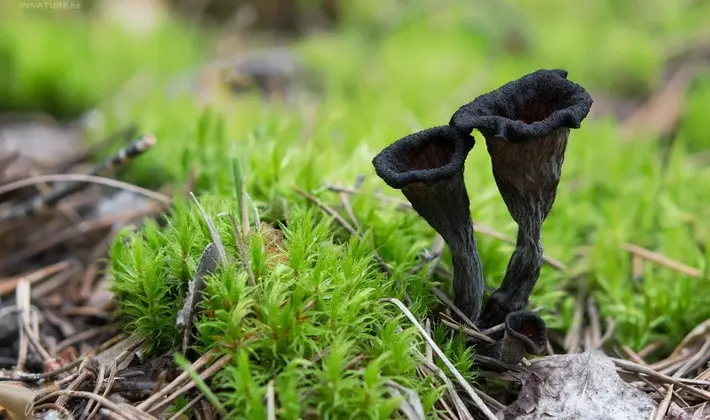
Leg narrowed to the base, brownish or black-brown, hard.
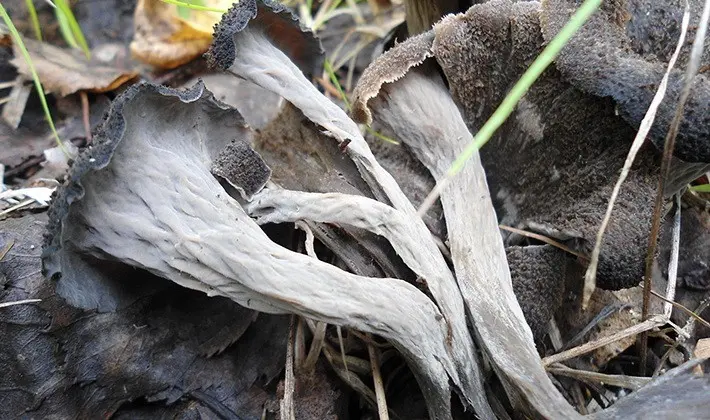
The flesh is brittle, membranous, gray. The inner surface is fibrous-wrinkled, brownish, gray-brown, brown-black or almost black. The edge is turned, uneven.
The upper tubular part is eaten fresh and dried. In Western Europe, the mushroom is considered a delicacy.
Ecology and distribution:
It grows in deciduous and mixed forests, in damp places, near roads.
Chanterelle yellowing (Cantharellus lutescens).
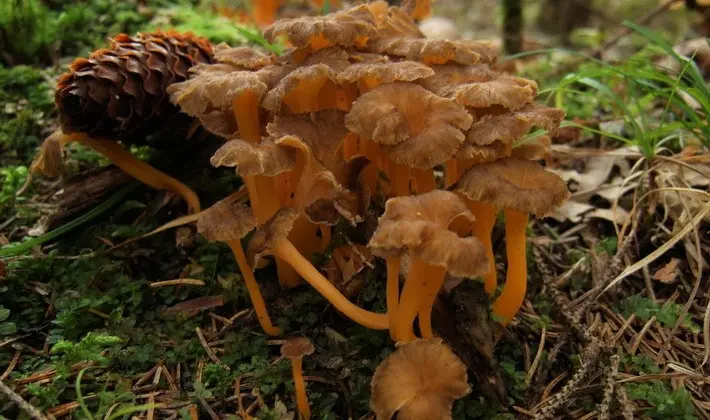
Family: Chanterelles (Cantharellaceae).
Season: Aug. Sept.
Growth: in groups.
Description:
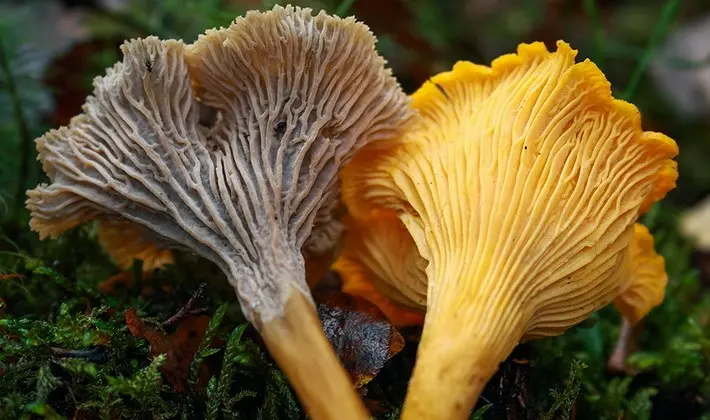
The pulp is dense, slightly rubbery, brittle, yellowish.
The leg is narrowed to the base, curved, golden yellow. The mushroom is tubular from the cap to the base.
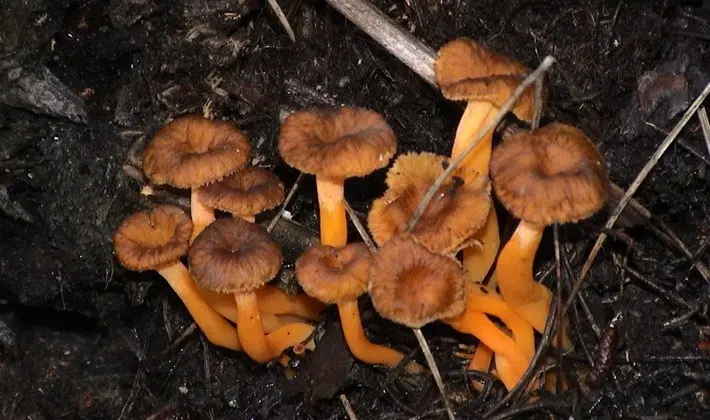
The cap is thin, elastic, dry, yellowish-brown. The plates of young mushrooms are not pronounced; later sinuous, yellow or orange, then grey.
Edible mushroom. It is used fresh (after boiling) and dried. As a finely ground powder, it is used in soups and sauces.
Ecology and distribution:
It grows in coniferous, more often spruce, forests.
Star-shaped and trellised mushrooms.
Archer’s Clathrus (Clathrus archeri).
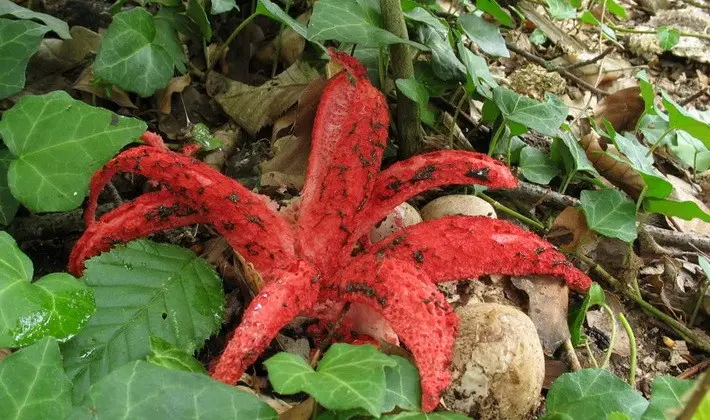
Family: Veselkovye (Phallaceae).
Season: July – October.
Growth: groups and alone.
Description:
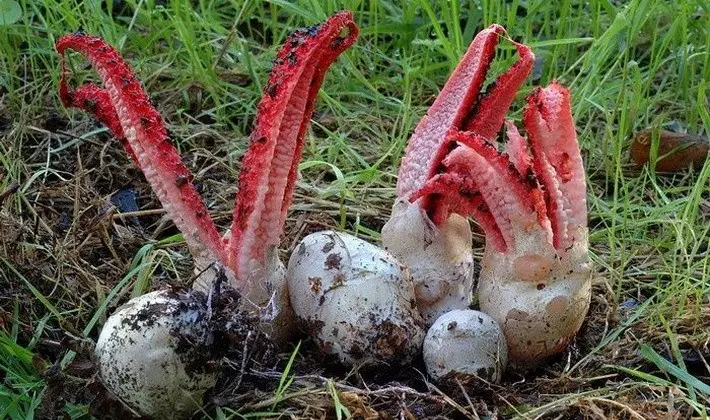
The lobes are initially fused at the tops. After the separation of the lobes, the fungus takes on a star shape.

The inner surface of the blades is spongy, covered with olive spots of spore-bearing mucus with a strong unpleasant odor. In the egg stage, the fungus is covered with a skin and a jelly-like shell underneath.
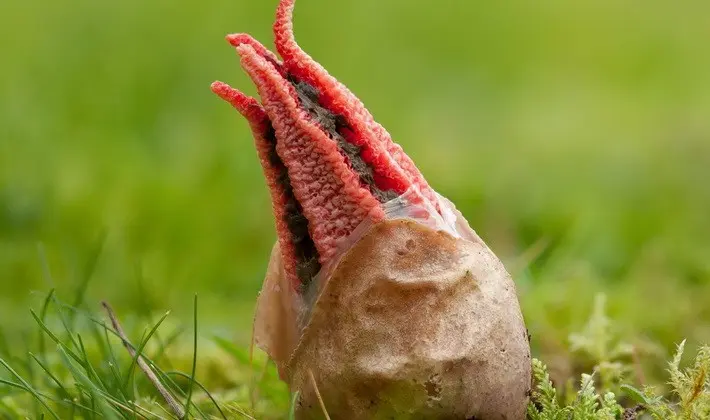
The young fruiting body is ovoid, grayish.
It has no nutritional value.
Ecology and distribution:
It grows on the soil of deciduous and mixed forests, meadows and parks. Found on sand dunes.
Lattice red (Clathrus ruber).
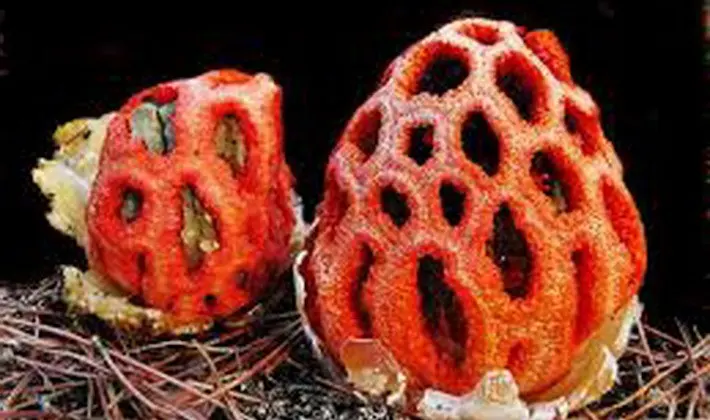
Family: Veselkovye (Phallaceae).
Season: spring – autumn.
Growth: groups and alone.
Description:
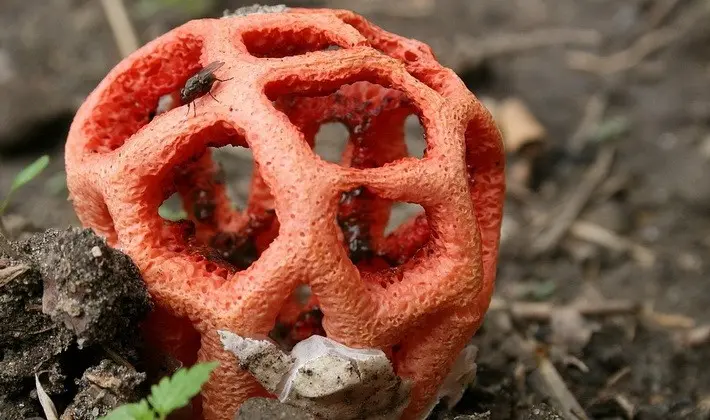
The mature fruiting body has the form of a spherical lattice of red color. The pulp is spongy, tender, in its mature form it has an unpleasant odor.
At the base of the fruiting body, remnants of a membranous cover are noticeable. White or brownish immature bodies are ovoid in shape.
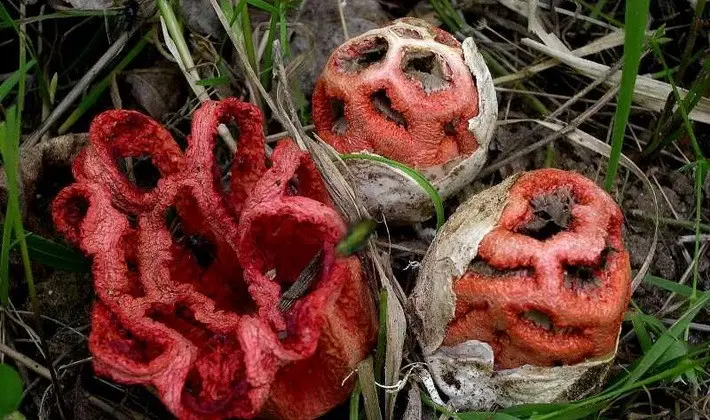
The inner surface of mature specimens is covered with olive-brown spore-bearing mucus.
Inedible mushroom.
Ecology and distribution:
It grows on forest litter and on the remains of decaying wood. In Our Country, it is occasionally found in the Krasnodar Territory. Listed in the Red Book of Our Country.
Unusual mushrooms from the Star and False rainfly families
Starfish fringed (Geastrum fimbriatum).
Family: Star-shaped (Geastraceae).
Season: fall.
Growth: groups or rings.
Description:
The fruiting body is initially spherical and develops in the ground. Later, the three-layer, rigid shell breaks and diverges to the sides like a star.
The spore outlet is fringed.
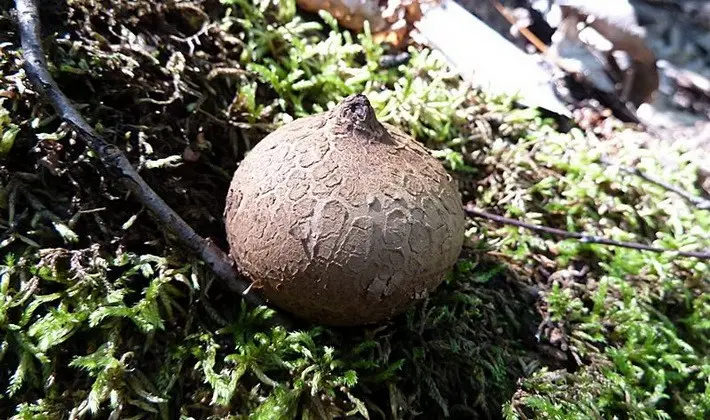
The spore sac is light gray, with a thin shell.
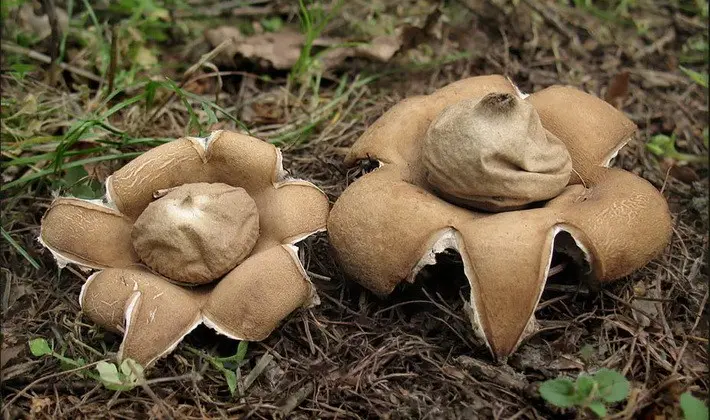
Individual blades begin to twist as the fruiting body emerges from the ground.
Young globular fruiting bodies can be eaten, but their flesh is poorly digested.
Ecology and distribution:
Grows on litter on alkaline soil under coniferous and deciduous trees.
Schmidel’s starfish (Geastrum schmidelii).
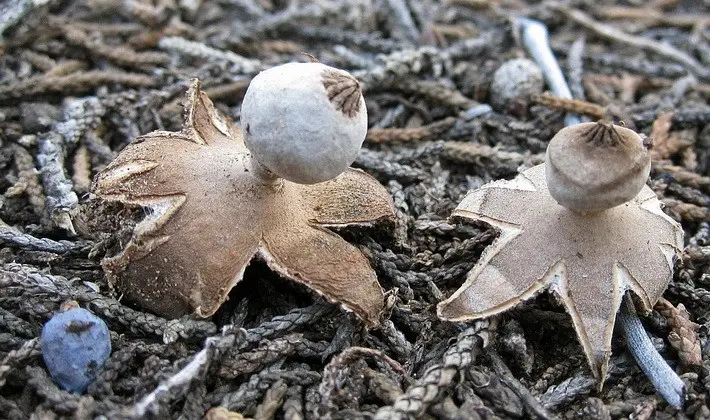
Family: Star-shaped (Geastraceae).
Season: July – September.
Growth: groups and alone.
Description of the unusual mushroom Schmidel’s starfish:
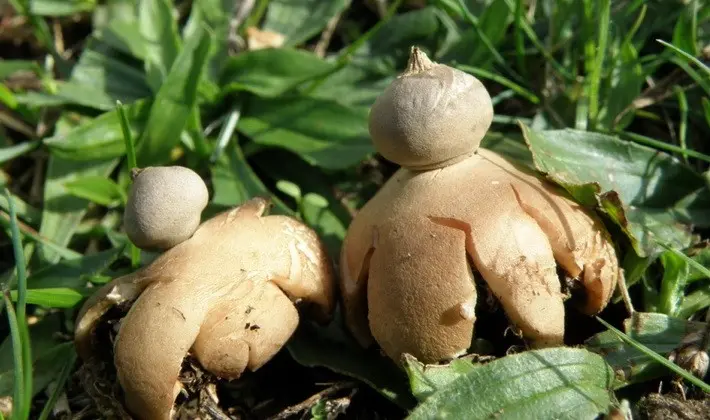
The spore sac is leathery, brown, with a small stalk. The spore outlet is surrounded by a fibrous fringe.
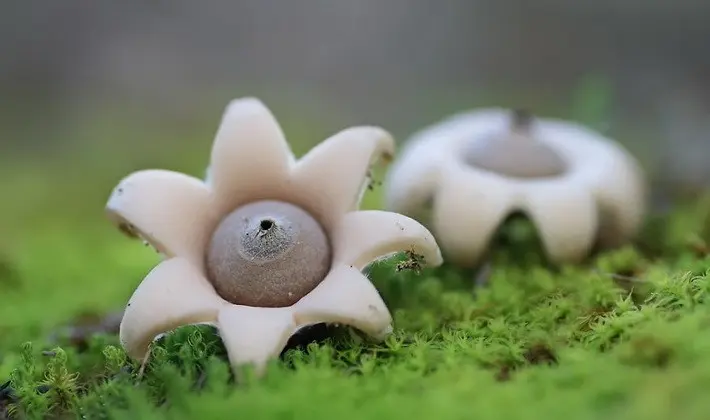
The inner side of the shell is smooth, rarely cracking, from light brownish yellow to light brown.
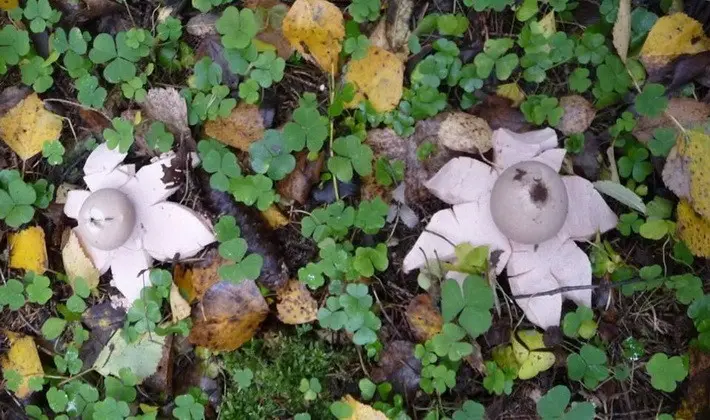
The thin outer shell of the fruiting body is torn into 5-8 unequal sharp lobes, wrapping their ends down.
Inedible mushroom.
Ecology and distribution:
Grows on soil and litter in deciduous and coniferous forests and forest plantations, in the steppes on the soil. Prefers light sandy soils. In Our Country, it is found in the southern regions of the European part, Siberia and the Far East.
Earth star triple (Geastrum triplex).
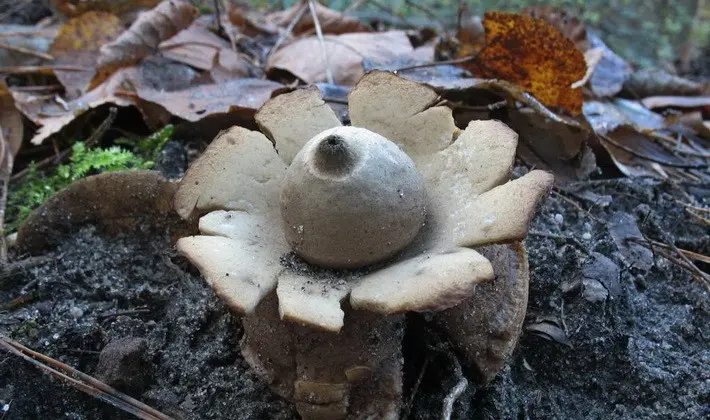
Family: Star-shaped (Geastraceae).
Season: end of summer – autumn.
Growth: in groups.
Description:

The outer layer of the shell forms a “star” when ripe. The young fruiting body has a turnip shape.
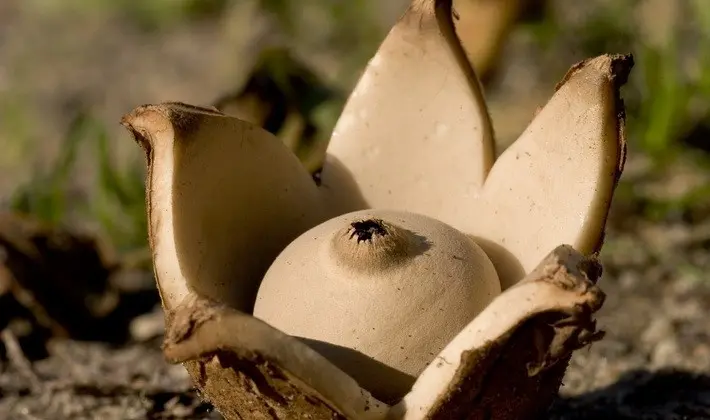
The spore exit hole is surrounded by a depressed area. The inner layer of the shell forms a characteristic “collar”.
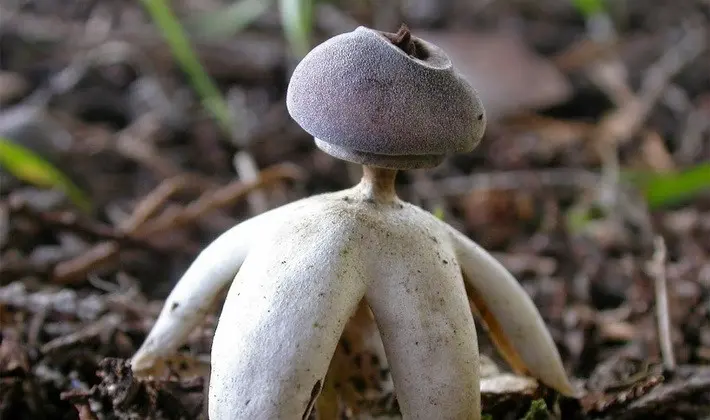
The spore sac is brownish.
Inedible mushroom.
Ecology and distribution:
It grows in deciduous and mixed forests, among fallen leaves and needles.
Starweed hygrometric (Astraeus hygrometricus).
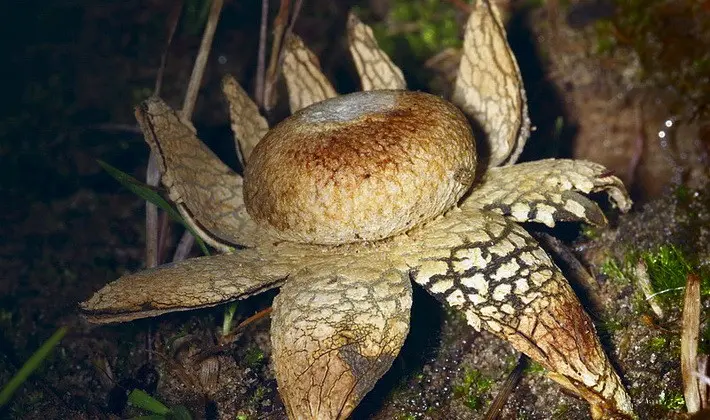
Family: False raincoats (Sclerodermatineae).
Season: year-round.
Growth: in groups.
Description:
When maturing, the outer shell cracks from top to bottom into 5-20 pointed lobes. In dry weather, the lobes bend, hiding the spore sac, and straighten when the humidity rises.
The inner surface of the lobes is gray to reddish-brown, rough, covered with a network of cracks and lighter scales. The spore sac is covered with a gray, gradually darkening sheath.
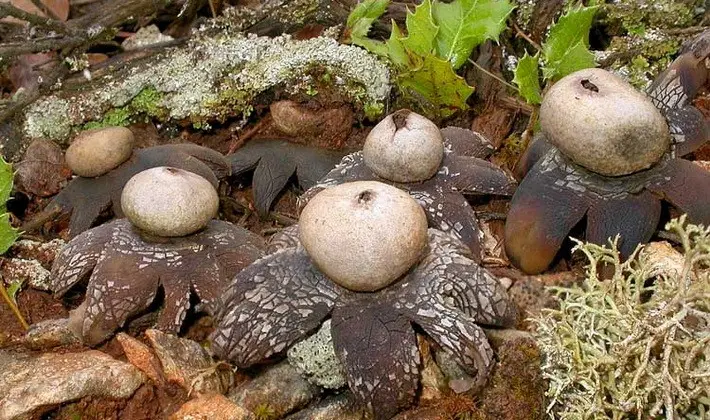
The immature fruit body is rounded, with a multi-layered shell, reddish-brown.
Inedible mushroom.
Ecology and distribution:
Grows on dry stony and sandy soil and loam in sparse forests, steppes and semi-deserts. In Our Country, it is found in the European part, in the North Caucasus, in Siberia, in the Far East.
Here you can see photos of unusual mushrooms, the names and descriptions of which are given above:
